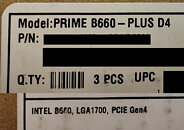Thursday, November 11th 2021

Intel B660 Motherboards May Lack PCIe 5.0 Support
The ASUS PRIME B660-PLUS D4 has allegedly been inadvertently sent instead of an ASUS Z690 motherboard to a reviewer for Alder Lake testing. The reviewer provided images of the product packaging to VideoCardz which clearly show a label indicating PCIe 4.0 support. This has come as a surprise as the Intel 12th Generation Alder Lake processors include attached PCIe 5.0 lanes separate from the chipset. The B660 chipset will target the mid-range market so the lack of PCIe 5.0 support on this specific motherboard may be a cost-cutting or artificial separation measure.
The first consumer PCIe 5.0 graphics cards and SSDs aren't expected to arrive until H1 2022 and will likely come at a significant premium so the exclusion of support could make sense for a more budget-oriented platform. Intel is also preparing to launch a higher-end H670 chipset which is expected to include PCIe 5.0 support. We cannot be sure if this label is accurate and if the lack of PCIe 5.0 support will apply to all B660 motherboards so take these rumors with a healthy dose of skepticism until the chipset and motherboards are officially unveiled.
Source:
VideoCardz
The first consumer PCIe 5.0 graphics cards and SSDs aren't expected to arrive until H1 2022 and will likely come at a significant premium so the exclusion of support could make sense for a more budget-oriented platform. Intel is also preparing to launch a higher-end H670 chipset which is expected to include PCIe 5.0 support. We cannot be sure if this label is accurate and if the lack of PCIe 5.0 support will apply to all B660 motherboards so take these rumors with a healthy dose of skepticism until the chipset and motherboards are officially unveiled.

78 Comments on Intel B660 Motherboards May Lack PCIe 5.0 Support
Until recently, Intel had no PCIe 4 support, and now it hurries for marketing "advantages", other than any meaningful use of the supported features.
The software is years and years behind, maybe after 5 years, the consumers will see any meaning in going to PCIe 5.
I find it rather odd, if anything the gen 5 support is best used on the DMI link, but they didn't do so.
While do SSDs do need it, but there is neither a slot to be put in, nor any devices themselves that support it.
Marketing fraud. Intel only.
In my opinion the PCI-E 5.0 x16 slot on Z690 MB is a total waste
They should split the 5.0 x16 to something like 4.0 x16+x8+x8
It will be sort of HEDT level of PCI-E capability
(CPU)
4.0 x16
4.0 x8
4.0 x8
4.0 x4
(Z690)
4.0 x4
4.0 x4
4.0 x4
What a wasted opportunity Intel.
Just marketing Hype
But the DMI is a lower hanging fruit that they can do. Since about 75% of the boards IO routes into the PCH, it is much more useful to double the bandwidth there.
They did went from DMI 3.0x8 to 4.0x8, but since they went with pcie 5.0 anyway, might as well go to DMI 5.0, but yet they didn't.
The chipset itself could have 8x 3.0x4 slot
Then you consider most boards have 2.5Gb ethernet and a couple of 20Gbps USB-C.
Some boards even get TB4 and 10Gb Ethernet on top of that.
All of those routes into the chipset and shares the DMI4.0 x8 link.
And on sites that are actually selling (but sold out), the prices are ridiculous for modules that are way worst even than crappy DDR4-2400.
Really, this 1st generation of DDR5 and PCI-E 5.0 needs to go away and go away fast. Everything is so OVER PRICED, with ZERO benefits and also way lower performance than expected (DDR5).
I don't know why the PC lags years behind in implementing games that make a use of this cool advantage.
You contradict yourself.
Yes, the PC doesn't utilise the speeds of the modern SSDs, which you actually just said:Stupid argument for the sake of the argument..
People that buy B*** boards do not change boards every year.
Also, keep in mind that, unlike AMD, B is not the mid-range chipset, it's the low-end/business oriented. Intel's mid-range is H chipsets.How are you taking lanes away from the GPU if none of the M2 slots are wired for PCIe5?
Keep in mind PCIe4 barely does a thing for SSDs. Sure, PCIe5 won't do much for video cards either, but that's easily solved on the developer side when they start shuffling larger textures more often...
The GPU PCIe5 slot on Z690 only has one benefit, which is marketing.